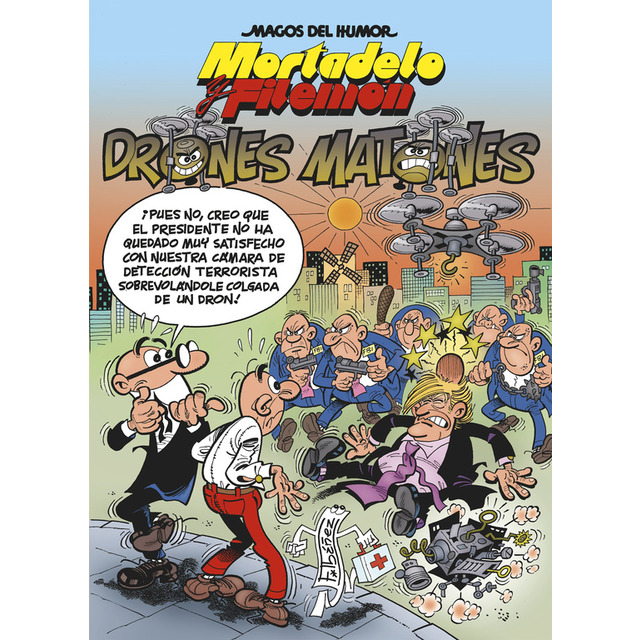

These editions were more satirical in regard to Spanish and international themes such as politics and political corruption ( El atasco de influencias), ETA's terrorism ( Barcelona '92) where the terrorist group were named as "TETA" ("]"), and "PEPA" in España '82, and the islamic one ( Terroristas or El balón catastrófico) or economics ( ¡Llegó el Euro!) among others. With those changes, the comics books were much longer (44-48 pages by comic book). The Técnicos de Investigación Aeroterráquea: "Aeroterrestrial Investigation Technicians") is an organisation that is a spoof on the CIA. In 1969, Ibáñez designed more characters. Their names are wordplay, for example: Mortadelo comes from Mortadela (" Mortadella di Bologna") and Filemón from Filete (" Steak"). The other one, Filemón, called by Mortadelo as " Jefe" ( Chief or Boss in English) had a beaked nose and use to smoke pipe as Sherlock Holmes used to do. However Ibáñez went to leave the hat on therefore Mortadelo get disguise inmmediately. He was known for his shapeshifter abilities.

At first, Mortadelo used to wear a bowler hat. Throughout the years, the characters have evolved. Every comics strip had from one to four pages. Its first title was Mortadelo y Filemón: Agencia de Información. It's one of the most popular comics in Spain.
#Historia de mortadelo y filemon series#
You don’t have to travel far to have a great time since this exhibit is on display in the center of Madrid at the Museo ABC de Dibujo e Ilustración (Calle Amaniel, 29) until February 25, 2018.Mort & Phil ( Mortadelo y Filemón in Spanish) is a Spanish comics series designed in 1958 by Francisco Ibáñez. As you can see, you have a perfect excuse to come to Madrid and make the most of your trip by doing some sightseeing. The organizers are also offering workshops for children between the ages of six and twelve. This third section is entitled “ Intimidades del tebeo”, dedicated to the creation and format of the various types of comics, including foreign comics. In this section, you will find comics filled with humor, romance and adventure and even some institutional themes (politics and religion). The second section is entitled “ “Géneros, personajes y autores”. First there is a timeline that discusses the origins and the progression of comics as well as their context. The exhibit is divided into three sections. Comic artists also had correction fluid on hand in case they needed to make corrections.


The originals are authentic works of art with fountain pens, paintbrushes and lots of India ink blank pages were filled with characters, vignettes and speech bubbles. In 1977 a leap was taken with the publication of the magazine Tótem containing comics for adults and that is why it was chosen as the endpoint for the exhibit. It begins in 1917 because that is when TBO was first published, the legendary magazine that gave name to the genre and marked the childhoods of many. This exhibit, great for the entire family, consists of 300 works: 180 are original drawings and 120 are comics. You can do so by visiting the exhibit “Historietas del Tebeo 1917-1977” where you will find famous characters such as Zipi y Zape, Mortadelo y Filemón, Capitán Trueno and even Tom Thumb. In Madrid you have the chance to journey through six decades of the 20th century with comic vignettes.


 0 kommentar(er)
0 kommentar(er)
